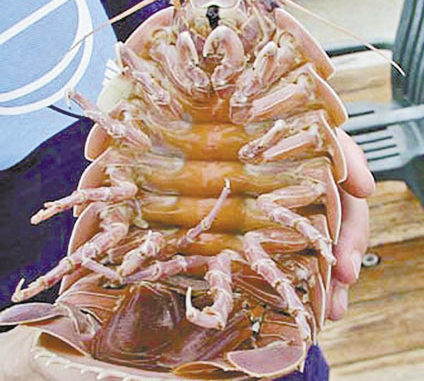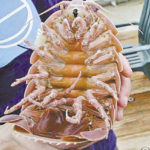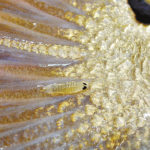
Never take a biologist fishing; they can really slow things down. So Ed Sexton, the great Trout Master, found. South of Venice, where Sexton fishes, he has to wade through a lot of redfish to catch the big sow speckled trout that he loves.
Any time spent with a redfish is less time that he has fishing for trout, so he likes nothing better than to get them fought, landed, unhooked and released as fast as possible.
Just as he was wrestling a big bull red over the side, he heard, “Wait, wait, wait,” from the back of the boat. I had spied a small shrimpy creature nestled between the rays of the fish’s tail fin.
While I was taking a close-up photograph of the little animal, Sexton was bent over my shoulder watching closely. After the first snap, the creature released its grip and began waltzing on around the tail of the fish, bowing and curtsying as it moved.
“Aw, look at the little fella. He’s dancing for us,” he said in amazement.
The little animal was a parasitic isopod.
In a sea where big fish eat little fish and then the bigger fish are eaten by even bigger fish, something has to eat the biggest fish of all. That something is often a parasite. Parasites are defined as creatures that grow, feed or are sheltered in or on a different organism while contributing nothing to the survival of its host.
In spite of their insect-like appearance, isopods are crustaceans, as are shrimp, crabs, crawfish and lobsters. About 10,000 species of isopods inhabit the world. Around 500 species live in fresh water. Another 4,500 live in ocean waters and something like 5,000 live on land.
Isopods are the most successful crustaceans to invade land. The small armadillo-like pill bugs, or rolly-pollys, so familiar to children are common land-dwelling isopods.
Marine isopods, the group under discussion here, are a widely varied group. Some are detritivores or scavengers that make their living plowing through bottom sediments looking for the remains of other creatures. A few species feed on plants such as mangroves and a few more are active predators, using modified forelegs and mouth parts to catch other animals.
But many are parasites, living off of fish and other crustaceans. Anglers who use grass or river shrimp for bait have all seen shrimp that have a large balloon-shaped bulge protruding from one side of their heads. The bubble in the shell houses a parasitic isopod — or really actually two or more of them, a very large and swollen female and one or more tiny males. The first isopod larva that gets in the shrimp’s head will develop into a female. All the later ones will turn into dwarf males.
Isopod parasites on fish can be found living on the outside of fish or in their gill cavities, depending upon the species of isopod. There, they make their living by feeding on the scales, flesh or blood of the fish.
Probably the most debilitating isopod infections in fish occur in the gills of young or small fish. An isopod attached to a small fish’s gill can grow so large that the gill cover protrudes strongly. The constant feeding action of the parasite can cause the gills to deform and stunt or even erode away. An isopod infection under both gill covers can kill the fish.
Infections of isopods that live on the skin, fins or even the eyes of fishes can also cause damage by causing anemia, slow growth, muscle shrinkage and allowing secondary infections to occur in the wounds they create. While a small number of isopods on a large fish are unlikely to cause noticeable problems for the fish, large swarms of these ectoparasitic isopods can kill fish as well as weaken them.
Like the isopods that parasitize freshwater shrimp, those that afflict fish have odd reproductive lives. They are protandrous hermaphrodites, meaning that they are typically born as males. The first male that parasitizes a fish will change to a female. Then, any isopods that attach to the same fish after the first one will remain males.
The most spectacular form of isopod parasitism of fish was discovered a few years ago. A substantial-sized (up to 1½ inches) isopod scientifically named Cymothoa exigua, and quickly dubbed the “tongue-eating louse,” was found in spotted rose snapper from the Gulf of California.
The parasite enters through the snapper’s gills, and then it attacks the fish’s tongue. It feeds so vigorously on its host’s blood that the tongue atrophies completely. The isopod then attaches its body to the muscles of the tongue stub.
Then, unbelievably, the fish will use the body of the parasite as a replacement for its own tongue. It doesn’t seem to cause any further damage to its host, but is contented with feeding on mucus and perhaps food scraps.
It is startling, however, for an unsuspecting human who opens a snapper’s mouth and finds a living ferocious-looking creature looking back at him.
The Gulf of Mexico does hold a certain honor in the isopod chronicles. It is home to the largest isopod in the world, the 30-inch long giant isopod, Bathynomus giganteus. Fortunately the big bug is not a parasite, but more of a generalized bottom scavenger and possibly a predator of slow-moving bottom life.
It is known to feed on dead whales, fish and squid, but has attacked trawl and longline catches, although little such fishing occurs in or over the depths at which the animal lives. Although some have been found as “shallow” as 560 feet deep, they seem most common in the eternal blackness of 1,200- to 2,400-foot depths.
Jerald Horst is author of six books on fish and seafood, including the acclaimed Trout Masters: How Louisiana’s Best Anglers Catch the Lunkers. His latest book is Game Warden: On Patrol in Louisiana. Both may be ordered at LouisianaSportsman.com, or by calling (800) 538-4355.




